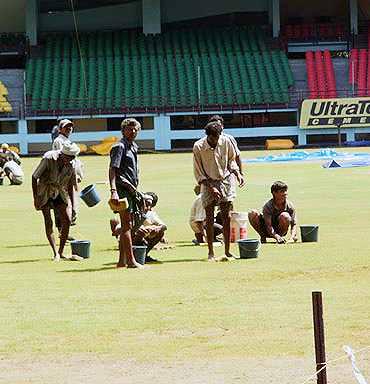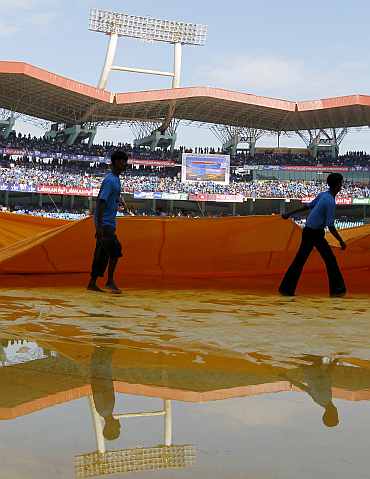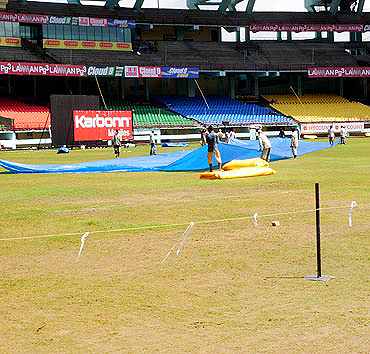 | « Back to article | Print this article |
Groundstaff worked round the corner to get ground ready
The absence of a proper drainage system proved to the Kerala Cricket Association's undoing in the washed out first ODI between India and Australia in Kochi, says Harish Kotian.
Following persistent rain in Kochi, the opening One-day International between India and Australia on Sunday was abandoned, allowing the players and journalists some well-deserved rest.
But one's heart went out to the hardworking groundstaff, who slogged non-stop day and night for the last three days to get the ground ready.
The Kerala Cricket Association also worked round the clock and were hopeful of the match, their first in three years, getting underway.
But those who suffered the most were Kerala's diehard cricket fans. Despite the chances of the game getting underway being bleak, it was a full house at the Jawaharlal Nehru stadium, with nearly 30,000 spectators in the stands.
Photograph: Harish Kotian
The covers were not enough to cover the entire ground
So who is to blame for the debacle that denied 'God's own country' a chance to witness a great contest between the world's top two ODI sides?
There was no rain on the eve of the match (Saturday), and the sun shone brightly the whole day; yet the ground was not match-ready. This was due to the pounding it received the previous two days.
Water accumulated on the outfield and some of it leaked through the covers. The covers were also not enough to shelter the entire ground, and the absence of a proper drainage system meant it would require at least a two more days' sunshine for the ground to be ready.
Overnight showers compounded problems and when it rained again on Sunday morning, the match was promptly called off at 1020 IST, nearly an hour after the scheduled start time.
Kerala Cricket Association (KCA) secretary TC Mathews admitted that the drainage system did not work, leaving huge puddles of water on parts of the ground.
"There seems to be a bit concern with the soil, because the surface was re-laid recently but the water is not percolating. We have the draining system and the percolator pipes are there below the soil, but maybe the percolation is not up to international match standards," he told rediff.com.
Photograph: Reuters
'It's not right to blame Kerala Cricket Association'
But then you cannot blame the association, because the Nehru Stadium, owned by the Greater Cochin Development Authority (GCDA), also houses football club FC Kochi. So both football and cricket are played on this ground.
And that, according to former BCCI ground and pitch committee chairman Daljit Singh, is the big issue with associations that do not have a ground of their own.
"The BCCI had made it clear in 2009 that all associations who stage international matches should have their own stadiums. I don't know what has happened to that policy, because still places like Kochi and Guwahati are borrowing grounds. The BCCI has supported all the association and gives them 50 crores every year, but still nothing is happening," Daljit said.
He pointed out that it is important that the BCCI finds out why the policy has not been implemented, because if a ground is shared then it's difficult to maintain it.
"I think it is not right to blame the Kerala Cricket Association. We must look at why the BCCI policy was not implemented -- of every association having a ground. My heart goes out to the public and the association because they waited for such a long time and then this happened," he said.
"During the last match in Kochi in 2007, I was the BCCI pitches committee chairman. Then too we had the same problem with a lot of rain and they had brought in the ropes quite a bit and somehow the match took place. I think one time it is acceptable, but you cannot do it again and again," he added.
Mohali has a very good drainage system
Daljit also explained how in Mohali they have one of the best drainage systems in the world, something that would work so well for a venue like Kerala.
"In Mohali, we have a very good drainage system and I remember, in two matches, against England and Pakistan, we started the match within a couple of hours of the rain stopping.
"In the match in England, it was raining the whole night and it stopped only at 7.30 but we were able to get the game started at 9.30. The players had not even left their hotel because it had rained so much, but we managed to get it out quickly and the same thing happened in one match against Pakistan," he said.
'It's important how you handle the covers'
Daljit introduced a major reform in the way pitches and outfields are being managed in the country during his tenure as the ground and pitches committee chairman. He was controversially sacked last December following the pitch fiasco in the fifth ODI between India and Sri Lanka at the Ferozshah Kotla in Delhi.
Daljit, who is serving as the chief curator at the Mohali stadium, explains how the drainage system works in cricket stadiums.
"There are two types of drainages, one is the surface-based draining and the other is herring bone system. Chennai is the only ground in India to use the herring bone system and the Wankhede stadium will also have it when it gets ready. In this system, you have a series of pipes connecting to a big pipe, which eventually takes out the water. So in this system, the water goes quickly and more the pipes the quicker it is to get the water out.
"If you do not have a herring bone system, then you should have the surface drainage system. In this you have a slope whereby the water rushes out quickly from the center to the boundary lines," he said.
Daljit also stressed that the groundstaff needs to have the experience on how to handle the covers once the rain has stopped.
"It is also important how you handle the covers because a lot of water can leak out on the ground when removing the covers. Therefore, you must have a sensible staff, who are experienced and ensure that water is taken out properly before taking off the covers," he said.
Photograph: Harish Kotian




